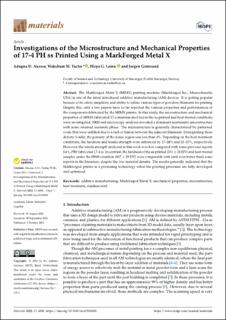| dc.contributor.author | Akessa, Adugna Deressa | |
| dc.contributor.author | Tucho, Wakshum Mekonnen | |
| dc.contributor.author | Lemu, Hirpa Gelgele | |
| dc.contributor.author | Grønsund, Jørgen | |
| dc.date.accessioned | 2022-10-21T11:36:39Z | |
| dc.date.available | 2022-10-21T11:36:39Z | |
| dc.date.created | 2022-10-06T13:24:26Z | |
| dc.date.issued | 2022-10 | |
| dc.identifier.citation | Akessa, A. D., Tucho, W. M., Lemu, H. G., & Grønsund, J. (2022). Investigations of the Microstructure and Mechanical Properties of 17-4 PH ss Printed Using a MarkForged Metal X. Materials, 15(19), 6898. | en_US |
| dc.identifier.issn | 1996-1944 | |
| dc.identifier.uri | https://hdl.handle.net/11250/3027574 | |
| dc.description.abstract | The Markforged Metal X (MfMX) printing machine (Markforged Inc., Massachusetts, USA) is one of the latest introduced additive manufacturing (AM) devices. It is getting popular because of its safety, simplicity, and ability to utilize various types of powders/filaments for printing. Despite this, only a few papers have so far reported the various properties and performances of the components fabricated by the MfMX printer. In this study, the microstructure and mechanical properties of MfMX-fabricated 17-4 stainless steel (ss) in the as-printed and heat-treated conditions were investigated. XRD and microscopy analyses revealed a dominant martensitic microstructure with some retained austenite phase. The microstructure is generally characterized by patterned voids that were unfilled due to a lack of fusion between the adjacent filaments. Disregarding these defects (voids), the porosity of the dense region was less than 4%. Depending on the heat treatment conditions, the hardness and tensile strength were enhanced by 17–28% and 21–27%, respectively. However, the tensile strength analyzed in this work was low compared with some previous reports for L-PBF-fabricated 17-4 ss. In contrast, the hardness of the as-printed (331 ± 28 HV) and heat-treated samples under the H900 condition (417 ± 29 HV) were comparable with (and even better than) some reports in the literature, despite the low material density. The results generally indicated that the Markforged printer is a promising technology when the printing processes are fully developed and optimized. | en_US |
| dc.language.iso | eng | en_US |
| dc.publisher | MDPI | en_US |
| dc.relation.uri | https://ssrn.com/abstract=4068014 | |
| dc.rights | Navngivelse 4.0 Internasjonal | * |
| dc.rights.uri | http://creativecommons.org/licenses/by/4.0/deed.no | * |
| dc.subject | additive manufacturing | en_US |
| dc.title | Investigations of Microstructure and Mechanical Properties of 17-4 Ph Ss Printed by Markforged Metal X | en_US |
| dc.type | Peer reviewed | en_US |
| dc.type | Journal article | en_US |
| dc.description.version | publishedVersion | en_US |
| dc.rights.holder | © 2022 by the authors | en_US |
| dc.subject.nsi | VDP::Teknologi: 500::Materialteknologi: 520 | en_US |
| dc.source.pagenumber | 26 | en_US |
| dc.source.volume | 15 | en_US |
| dc.source.journal | Materials | en_US |
| dc.source.issue | 9 | en_US |
| dc.identifier.doi | 10.3390/ma15196898 | |
| dc.identifier.cristin | 2059193 | |
| dc.source.articlenumber | 6898 | en_US |
| cristin.ispublished | true | |
| cristin.fulltext | original | |
| cristin.qualitycode | 1 | |

